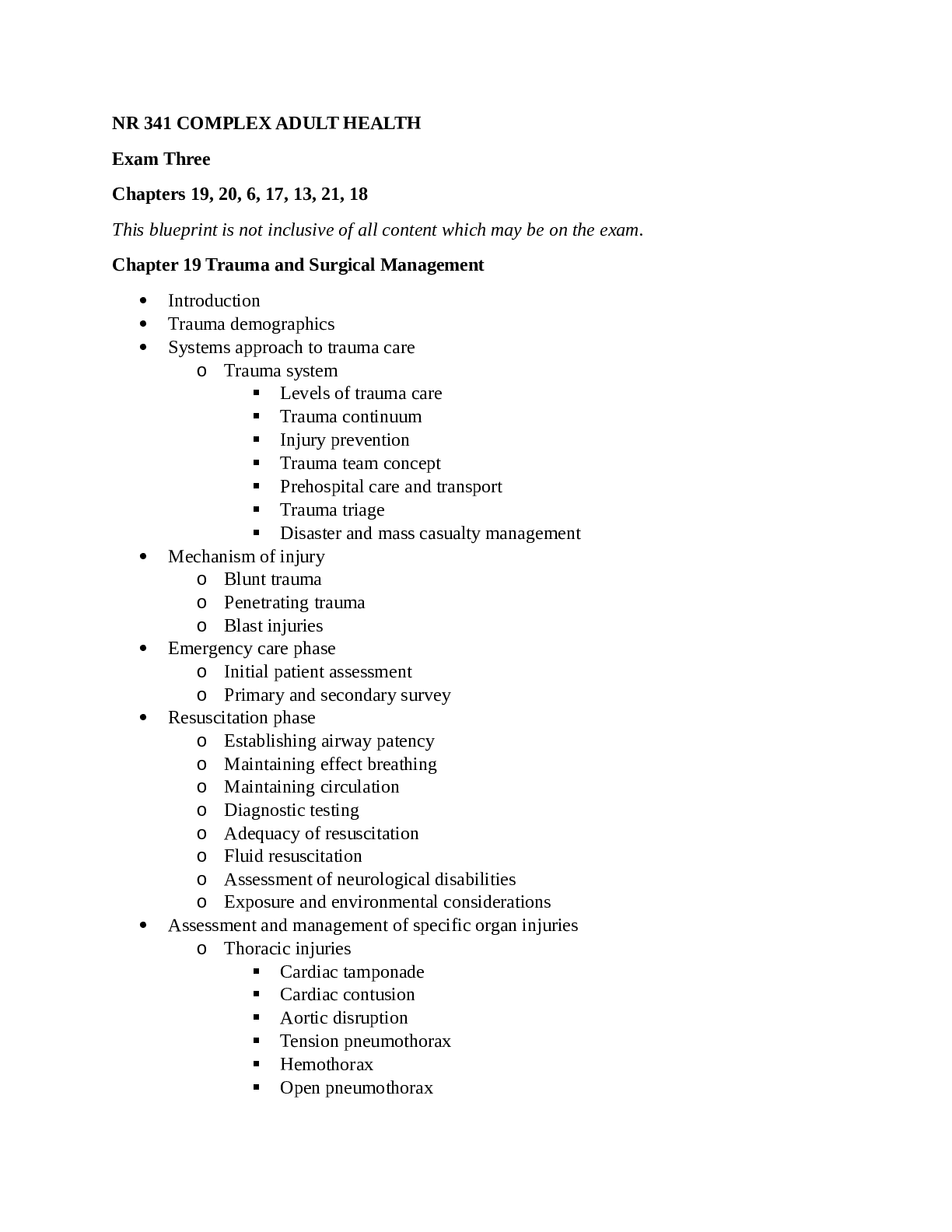*NURSING > STUDY GUIDE > NUR 265 EXAM THREE STUDY GUIDE. A GRADED (All)
NUR 265 EXAM THREE STUDY GUIDE. A GRADED
Document Content and Description Below
NUR 265 EXAM THREE STUDY GUIDE. A GRADED.UNIT 7 ENCEPHALITIS • Inflammation of the brain tissue- the ventricles. – affects the cerebrum, the brain stem, and the cerebellum • Normally caused... by a virus o Herpes o Polio o Mosquito borne viruses- west Nile o Tick borne viruses o Rabies o Childhood viruses • Signs/symptoms: o High fever o Nuchal rigidity- occurs only if brain stem infected o Photophobia o Phonopobia o Headache o N/V o Altered LOC o s/s of increased ICP o fatigue o joint pain o vertigo o muscle spasms o ataxia o tremors • diagnosing: o history of any viruses, mosquito bites, or swimming in lakes- all within the last month o lumbar puncture analyze CSF PCR test to detect viral DNA o EEG for brain wave activity or seizure o CT scan- hydrocephalus o Blood cultures- viruses • Assessment: o Q 4-hour neuro checks Glasgow coma scale Cranial nerve assessment Change in LOC or orientation • Nursing considerations o Maintain airway o Monitor for increased ICP o Monitor for vitals and neuro frequently o Reduce stimuli- darken the room, turn down TV, put them at the end of the hall o Treat the symptoms • Treatment o Acyclovir- antiviral Need to begin as early as possible o Prevention Using DEET spray on self Avoid people with herpes outbreak, etc. MENINGITIS • Inflammation of the meninges (layers covering brain) specifically the pia mater and arachnoid • Can be viral or bacterial- bacterial is much worse • People ages 16-21 have highest rate of bacterial meningitis. CDC recommends initial vaccine at 11-12 and a booster at 16. Adults are advised to get initial or booster vaccine if living in a shared residence like a dorm, traveling or residing in a foreign country which disease is common, or are immunocompromised due to a damaged or surgically removed spleen. It is safe to receive booster 8 weeks after initial vaccine incase initial vaccine status not known. • Bacterial o Occurs in outbreaks such as dorm rooms o Caused by Neisseria meningitides and streptococcus pemoniae o High mortality rate o Droplet precautions- CONTAGIOUS! o Private room • Viral o Non-contagious o Caused by mumps, HIV, herpes zoster, etc. o Low mortality rate o Standard precautions • Symptoms o Fever o Nuchal rigidity- THIS IS A CLASSIC SIGN!!! o Photophobia o Phonophobia o Headache o N/V o Change in LOC o s/s increased ICP o muscle aches o maculopapular rash o petechial rash o seizures o SIADH o SIRS/DIC • Diagnosing: o Lumbar puncture for CSF Virus- clear, normal pressure and no organism found Bacterial- cloudy, turbid, increased WBC! Increased protein, decreased glucose, and elevated CSF pressure o Gram stain- done to see which bacteria it is o Counterimmunoelectrophoresis (CIE)- preformed to determine presence of virus o Kerning’s sign- when doctor forces the patent’s head up, the patient’s knees will flex inward toward the core involuntarily • Nursing considerations o Bacterial patient must be on droplet precautions. Stay 3 feet away from patient unless you are wearing a mask. Teach patient and visitors about need to wear a mask o Neuro checks Q 4 hours o Monitor for ICP o Reduce stimuli o Treat the symptoms • Treatment: o Do NOT delay treatment while waiting to preform tests or obtaining test results o If meningitis’s is suspected, broad spectrum antibiotic immediately! o Decreased external stimuli- keep ICP down o Treat symptoms like fever o Prevent complications- DVT, PE, ICP, seizures. TRIGEMINAL NEURALGIA • Disorder that affects the trigeminal nerve- the fifth cranial nerve • Trigeminal nerve has 3 branches- sensation in person’s eye, upper eyelid, and forehead, lower eyelid, cheek, nostril, upper lip, and upper gum, jaw sensations lower lip, lower jaw, and muscles for chewing • Trigeminal nerve basically controls the middle of the face • Chronic pain syndrome in those areas of the face. • Pain is described as excruciating, sharp, shooting piercing, burning, etc. • Triggers- like brushing teeth, light touch stimulation, change in facial expressing (smiling), chewing, • Fear of pain stops them from talking, smiling, eating, or attending to hygienic tasks • Priority is pain management! • Medications o Carbamazepine- first choice drug- anti-epileptic. o Muscle relaxants • Percutaneous sterotactic rhizotomy [Show More]
Last updated: 2 years ago
Preview 1 out of 35 pages

Buy this document to get the full access instantly
Instant Download Access after purchase
Buy NowInstant download
We Accept:

Reviews( 0 )
$15.00
Can't find what you want? Try our AI powered Search
Document information
Connected school, study & course
About the document
Uploaded On
Feb 21, 2021
Number of pages
35
Written in
Additional information
This document has been written for:
Uploaded
Feb 21, 2021
Downloads
0
Views
83















.png)

